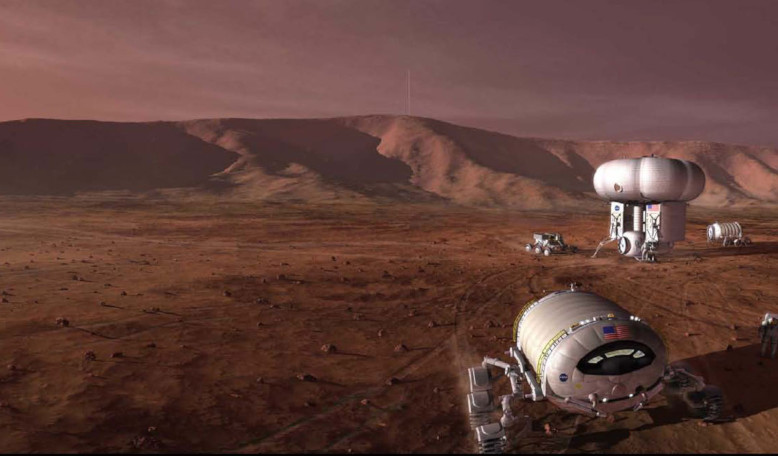The prospect of heading to Mars by 2033 has suffered a setback, as an independent report which US Congress directed NASA to conduct in the 2017 NASA authorisation act, suggests that a Mars orbital mission could be carried out no earlier than 2037, and would slip to 2039 or later if delays occur or budgets overrun.
Trump’s administration have been very outspoken recently in their plans to return astronauts to the Moon by 2024 and then forward on to Mars within a decade. The announcement, made by Vice President Mike Pence last month, turned heads as the date for a return to the lunar surface was four years ahead of its previous schedule - a shift that has been seen as coinciding with President Trump’s last year in office, if he’s elected for a second term.
Following the statement, NASA head Jim Bridenstine then declared that NASA wants to “achieve a Mars landing in 2033.” This can be accomplished he said, while speaking at a congressional hearing on Capitol Hill, if NASA accelerate its Moon landing plans. “The Moon is the proving ground,” said Bridenstine.
Although the report, which NASA contracted the Science and Technology Policy Institute (STPI) to complete long before the speech by Vice President Pence in March this year, is to evaluation a human mission to Mars, the Moon is indeed the key. In order to reach Mars, a viable lunar-base is needed that can be used as a platform for launching vehicles deeper into space.
For this, NASA is relying on the Gateway; a small moon-orbiting space station that will serve as a jumping-off point for robotic and crewed missions to the lunar surface and beyond. Its assembly is scheduled to begin in 2022. However, the segments that make up the Gateway have to be delivered somehow and NASA's delayed development of its new heavy-lift rocket the Space Launch System (SLS) could have an impact on realising these goals on time.
Even if commercial companies were contracted to pick up the slack if the SLS is not ready in time, a possibility noted by Bridenstine himself, the report states that this element of the overarching plan is not necessarily a problem in holding progress back; “due to long development programs and ongoing testing, SLS and Orion present low technology risks to a Mars orbital mission.’
Instead it suggests that one of the stumbling blocks for a Mars mission could be the space station itself; “overall, the Gateway presents medium technology risk because certain technologies (e.g., xenon refuelling and autonomous environmental monitoring) have not been previously demonstrated at the scale required by the Gateway,” says the report. “If additional modules are added, or mission requirements expand, the Gateway would face higher technology integration risk, especially for power, propulsion, and life support systems originally sized for a small Gateway.”
The Gateway would also be critical for in-space testing of the Deep Space Transport (DST), a vehicle that the repot says will take a crew on a 1,100-day crewed mission to the Red Planet. All four elements (SLS, Orion, Gateway, and the DST) therefore need to be developed and completed in order to launch a human mission to orbit Mars.
Furthermore, the schedule developed in the report rests upon critical assumptions, one of which is that there will be no more than one human mission to the Gateway annually, either to work aboard the Gateway, operate the DST, or to transfer to the lunar surface. This would require NASA to make compromises between focusing on lunar landings and preparing the DST for the mission to Mars.
All of this, the report finds, could be a stretch even if the monetary aspect of it all is not an issue; “we find that even without budget constraints, a Mars 2033 orbital mission cannot be realistically scheduled under NASA’s current and notional plans… Further budget shortfalls or delays in the construction or testing of the DST would likely require the mission to depart for Mars in 2039 at the earliest.”
And just what would be the cost of of putting all of this together? The STPI report estimates that the total cost for the development and operation of the core architectural elements I.e the Orion, SLS, the Gateway, and the DST, between FY 2019 and FY 2037 “may be up to $83 billion in FY 2017 dollars, including 10 to 30 percent reserves, but not including possible overruns.” But, including the costs incurred during the orbital mission through 2040, the report adds further “that the total estimated cost of a human mission to Mars orbit is $87 billion in FY 2017 dollars.”
The report has apparently received a lukewarm reaction on Capitol Hill, and Rep. Kendra Horn, chairwoman of the House space subcommittee, in prepared remarks for an earlier hearing by the full House Science Committee on the NASA budget request on 2 April is noted as saying; “According to the report, it’s clear that getting to the surface of Mars in the 2030s is impossible under this Administration’s current approach to exploration,” she wrote in those remarks. “Moreover, the report acknowledges what many on this Committee have been surmising during past hearings — namely, that there is no actual Plan for a human Mars mission.”
If the underlying driving force of getting to the Moon by 2024 is achievable then perhaps not all is lost. But, building a lunar infrastructure, while developing a host of new deep space technologies at the same is not cheap and the Campaign Report, used as the basis of the STPI report, foresees no dramatic new funding to assist with the many plates NASA has spinning in the air. “With such ambitious content and fixed funding, the only remaining variable is schedule,” the report concludes. Unless of course, more money is made available to fund it all.











